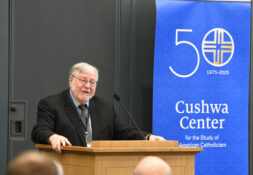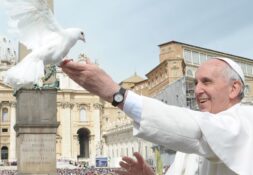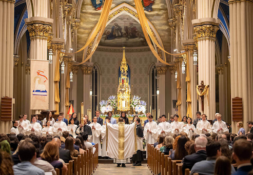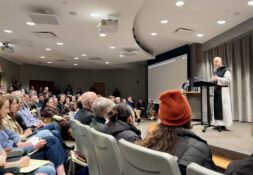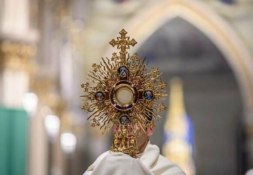A glimpse into the windows of Basilica of the Sacred Heart
The Basilica of the Sacred Heart at Notre Dame contains one of the few complete collections of French stained glass outside of Europe. The windows are remarkable in their history, detail, and theological content. The story of these distinguished works of art is told in Stories in Light, a 2020 book written by Nancy Cavadini and Cecilia Davis Cunningham and published by the University of Notre Dame Press.
The windows come from the Fabrique du Carmel du Mans, the glassworks of a Carmelite monastery in Le Mans, France—the city in which Blessed Basil Moreau founded the Congregation of Holy Cross in 1837. Father Edward Sorin (1814–1893), prior to his leaving for Indiana, was a temporary chaplain at the neighboring monastery. Though different in their charisms, the Carmelite nuns and members of Holy Cross, because of their proximity, enriched each other and shared a “union of prayer,” as Stories In Light describes.
The story of the basilica stained glass begins not in South Bend but in Le Mans when the infant Congregation of Holy Cross started construction on its mother church in 1842. Though initially the Congregation was too poor to even consider stained glass windows, Drouet, their glazier (a craftsman who cuts and installs glass), proposed that they, with his help, produce stained glass. Holy Cross Glassworks, a company staffed by brothers and priests, was founded in 1845.
As they became more knowledgeable and skilled, the brothers no longer needed Drouet.
They built the glass furnace, made different colored glass, and in total produced nineteen windows.
Though Holy Cross Glassworks proved to be short-lived, closing in 1852, their attempt inspired their neighboring Carmelites to establish their own glassworks. Out of financial need and a desire to build a chapel, the Carmelites in 1851 took out a loan. Father Jean-François Lottin, who was close to both religious orders, suggested that the Carmelites make their own windows as the brothers of Holy Cross had done. In fact, Holy Cross lent their tools and glass furnace to the Carmelites. Thus began the Carmelites’ stained glass window enterprise, which outlived that of the Congregation, producing more, and eventually exporting as far as Japan.
Cavadini and Cunningham speak of a certain mystery about the Carmelites’ early work: since the Carmelites were cloistered, it is unclear how they initially learned to make the windows. However, they soon required a workshop external to the monastery, and the Carmelites came to function more as the directors of the business, though they were involved in painting. Though it became a larger and external enterprise, the Carmelites wanted the art from their glassworks to be put at the service of faith. In the spirit of the Brotherhood of St. Luke, a group of painters across Europe that sought to revive theology in art, the Carmelites saw the stained glass windows as having a pedagogical dimension, teaching and conveying theological truths while also aiding man in his ascent toward the Beautiful.
Father Sorin, in 1870, decided to expand the original church of Notre Dame. Remembering his Carmelite friends in Le Mans (and perhaps hoping to receive a discount), Sorin ordered a large amount of stained glass from the Fabrique du Carmel. The Carmelites during that time had been seeking to sell their glassworks, however, and because of the Franco-Prussian War, there was a pause in the production of stained glass.
Though the Carmelites experienced financial hardships during the war, they replaced their chapel’s windows to provide work for their employees. Interestingly, the drawings of their new windows, which depicted Carmelite saints, were also used for the basilica. Before the work on the basilica’s windows had begun, the Carmelites, in 1873, sold their glassworks to Edouard Rathouis, an importer of glass and the mother prioress’ nephew. Though the glassworks’ ownership had changed, the artists and craftsmen were still committed to the religious vision of the Carmelites.
Over at Notre Dame, the Long Depression meant a need for sponsors to pay off the glass order. With Sr. M. Germaine of the Passion’s donation of her inheritance, Notre Dame was able to pay for the stained glass. Moreover, because of Father Sorin’s involvement, Notre Dame received a ten percent commission on the windows, and so he promoted the Carmel glassworks.
The basilica windows were the major work of the Carmel du Mans, as the craftsmen realized that Notre Dame “gave them an opening to a valuable market beyond the constant upheavals of French society, government, and finances” (Stories in Light, 10). The windows in the basilica reveal details of French spirituality and its devotions, though there remains no account of the motivation behind the selection of the windows (Notre Dame’s letters to the Carmelites were lost in a fire).
The Church radiates God’s presence in her saints, her sacraments, and her art. The stained glass windows of the Basilica have a story, but they also illustrate and point us to another story—the story of God sanctifying and renewing man. The windows of the saints speak of communion, as those on earth join those in heaven in singing praises to God, together participating in the Mass. From a thirteen year old martyr, Saint Philomena, who remained faithful to God in her consecration, to a farmer, Saint Isidore, who was faithful to God in his daily work, the windows of the different saints also encourage us in our striving toward holiness. The saints, the theological virtues, the four evangelists, the sacraments, the Holy Family, scenes of the Crucifixion, are but some of the numerous themes found in the stained glass windows of the Basilica, and they inspire powerful meditations on God, beauty, and salvation history. May we once again enter the Basilica, behold, pray, and, with grateful hearts, exclaim as did the English priest and poet, Francis Thompson, “O world invisible, we view thee … O world unknowable we know thee!”
Cavadini, N., & Cunningham, C. D. (2020). Stories in Light: A guide to the stained glass of the basilica at the University of Notre Dame. University of Notre Dame Press.
Francis Thompson, “The Kingdom of God”
Vanessa Franco is a junior from Southern California majoring in the Program of Liberal Studies and Theology. When she’s not admiring the pretty colors of the basilica stained glass or talking with her roommate Anne Marie about how amazing Les Misérables is, she’s probably cheerfully struggling through her mountains of books. Feel free to send her any book recommendations! She can be reached at vfranco@nd.edu.
Image source and credit:
One of the French windows in the basilica depicting the descent of the Holy Spirit. Photo by Carol Highsmith, 2016.
https://www.loc.gov/resource/highsm.41424/?r=-0.924,-0.502,2.848,1.643,0
